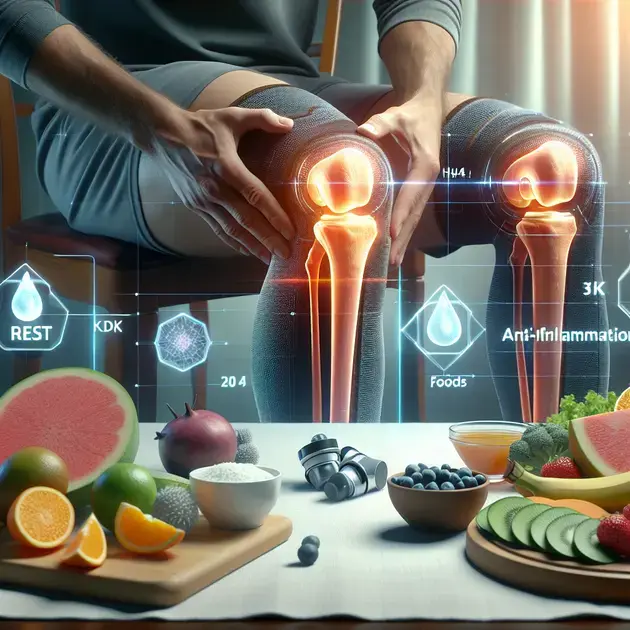If you’re looking to strengthen your knees and improve your overall knee health, incorporating effective exercises into your routine is key. Strong knees are essential for mobility and can help prevent injuries, especially as we age.
According to recent studies, focusing on exercises that target the muscles surrounding the knee joint, such as the quadriceps and hamstrings, can significantly reduce knee pain and improve function. In this blog post, we’ll explore some of the most effective exercises you can do to strengthen your knees and enhance your overall quality of life.
Effective Exercises to Strengthen Your Knees
When it comes to strengthening your knees, incorporating the right exercises into your fitness routine is crucial. Here are some effective exercises that can help you build knee strength:
1. Squats
Squats are a great way to target the muscles around your knees, including your quadriceps and hamstrings. To perform a squat correctly, stand with your feet hip-width apart, lower your body as if you’re sitting back into a chair, and then push through your heels to return to the starting position. You can use apps like Nike Training Club or check out videos on YouTube for guidance on proper squat form.
2. Lunges
Lunges work on your balance and stability, which are essential for knee strength. Start by stepping forward with one leg and lowering your body until both knees are bent at a 90-degree angle. Push back to the starting position and repeat on the other leg. Apps like MyFitnessPal or FitOn offer lunge variations to challenge yourself further.
3. Leg Extensions
Leg extensions target the quadriceps, helping to support the knee joint. You can perform this exercise using a resistance band or at the gym on a leg extension machine. Make sure to start with a weight that is comfortable for you and gradually increase resistance as your strength improves. Websites like Bodybuilding.com provide detailed instructions on how to perform leg extensions correctly.
4. Step-Ups
Step-ups are a simple yet effective exercise that engages your quadriceps and glutes. Find a stable platform or bench, step onto it with one foot, and then step back down. Repeat on each leg for a set number of repetitions. You can track your progress using fitness apps like Strava or Fitbit to stay motivated.
5. Clamshells
Clamshells target the muscles on the sides of your hips, which play a role in stabilizing the knees. To do clamshells, lie on your side with your knees bent and lift your top knee while keeping your feet together. Lower it back down and repeat on both sides. Apps like Fitness Blender offer guided workouts that include clamshell exercises.
Top Workouts for Knee Strength
When focusing on knee strength, it’s essential to incorporate a variety of workouts that target different muscle groups. Here are some top workouts that can help improve the health of your knees:
1. Cycling
Cycling is a low-impact exercise that can help strengthen the muscles around your knees without putting too much stress on the joint. Whether you prefer indoor cycling classes on apps like Peloton or outdoor biking using Strava routes, cycling can be an excellent way to improve knee strength and cardiovascular fitness simultaneously.
2. Swimming
Swimming is another low-impact workout that can engage all the major muscle groups, including those around your knees. Consider following a swim workout plan from Swim.com or Speedo Fit to incorporate different strokes and intensities to challenge your muscles and improve knee stability.
3. Pilates
Pilates focuses on strengthening the core muscles, which can indirectly benefit the knees by improving overall body alignment and balance. You can try online Pilates classes on websites like Blogilates or Pilates Anytime to target specific muscle groups that support knee function.
4. Yoga
Yoga poses can help increase flexibility, strength, and balance, which are essential for knee health. Poses like Warrior II, Tree pose, and Chair pose can target the muscles around the knees. Apps like Down Dog or Alo Moves offer a wide range of yoga classes catering to different levels and goals.
5. Resistance Training
Incorporating resistance training into your workout routine can help build muscle strength around the knees, promoting joint stability. You can use apps like JEFIT or Strong to create personalized strength training programs that include exercises like deadlifts, leg presses, and calf raises to improve knee strength.
Boost Your Knee Health with These Exercises
To enhance your knee health and prevent injuries, it’s essential to perform exercises that focus on strengthening the muscles that support the knee joint. Here are some exercises that can help boost your knee health:
1. Hip Abductor Exercises
Strengthening the hip abductor muscles can improve hip and knee alignment, reducing the risk of knee issues. Try exercises like side leg raises and hip hikes to target these muscles. Fitness apps like 8fit or Fitbod offer variations of these exercises to add to your workout routine.
2. Hamstring Curls
Hamstring curls target the muscles at the back of your thighs, which play a crucial role in knee stability. You can perform this exercise using a stability ball, resistance bands, or a leg curl machine at the gym. Follow a hamstring curl workout plan from apps like Fitbod or Gymaholic to strengthen these muscles effectively.
3. Balance Exercises
Improving your balance can help prevent falls and injuries that may impact your knees. Incorporate exercises like single-leg stands, toe touches, or balance board drills into your routine to challenge your stability. Websites like Verywell Fit or ACE Fitness provide guidelines for incorporating balance exercises into your workouts.
4. Foam Rolling
Foam rolling can help relieve muscle tightness and improve blood flow to the muscles around your knees. Use a foam roller to target the quadriceps, hamstrings, and calves regularly. Apps like My Foam Roller or TriggerPoint can guide you on proper foam rolling techniques for knee health.
5. Ankle Strengthening Exercises
Strong ankles can contribute to better knee stability and overall lower body strength. Perform exercises like ankle circles, calf raises, and alphabet drills to strengthen the muscles around your ankles. You can find ankle strengthening workouts on platforms like NASM or ACE to incorporate into your exercise routine.
Workout Routines for Healthy Knees
When it comes to maintaining healthy knees, incorporating workout routines specifically targeting the knee joint can be highly beneficial. These exercises not only help in strengthening the muscles around the knee but also enhance flexibility and stability. Consistent practice of these routines can contribute to overall knee health and prevent potential injuries in the long run.
Step-by-Step Guide:
1. Warm-up: Begin your workout with a proper warm-up session to prepare your muscles for the exercises that follow. This can include light cardio exercises like jogging or cycling to increase blood flow to the knee joint.
2. Strengthening Exercises: Incorporate exercises such as leg raises, squats, and lunges to strengthen the quadriceps, hamstrings, and calf muscles. These exercises help in providing support to the knee joint and improving its stability.
3. Stretching: Include stretching exercises like hamstring stretches and calf stretches to enhance flexibility in the knee joint. Stretching helps in maintaining a good range of motion and reduces the risk of stiffness.
4. Low-Impact Cardio: Opt for low-impact cardio exercises such as swimming or using an elliptical machine to improve cardiovascular health without putting excessive strain on the knees.
5. Cool Down: Finish your workout with a cool-down session that involves stretching and deep breathing exercises to relax the muscles and prevent post-workout soreness.
Improve Knee Stability with These Exercises
Enhancing knee stability is crucial for maintaining overall joint health and preventing injuries. By incorporating specific exercises focused on improving stability, you can strengthen the supporting muscles around the knee and enhance its functionality. Consistent practice of these exercises can lead to improved balance and reduced risk of knee-related issues.
Step-by-Step Guide:
1. Balance Exercises: Include exercises such as single-leg stands and balance drills to improve proprioception and strengthen the stabilizing muscles around the knee joint.
2. Resistance Training: Use resistance bands or weights to perform exercises like leg extensions and leg curls, targeting the quadriceps and hamstrings for enhanced stability.
3. Core Strengthening: Focus on strengthening the core muscles through exercises like planks and Russian twists, as a strong core contributes to overall body stability and support for the knees.
4. Proprioceptive Training: Incorporate exercises that challenge your balance and coordination, such as using a balance board or stability ball, to improve joint proprioception and stability.
5. Functional Movements: Integrate functional movements like squats and lunges into your routine to mimic real-life activities and improve overall knee stability during daily tasks.
**
Conclusion
**
Workout routines targeting the knee joint play a crucial role in maintaining healthy knees. By engaging in exercises that focus on strengthening the muscles surrounding the knee, individuals can enhance flexibility and stability, ultimately contributing to improved knee health and a reduced risk of potential injuries in the long term.
Following a step-by-step guide that includes warm-up sessions, strengthening exercises like squats and leg raises, as well as stretching routines such as hamstring stretches, individuals can ensure they are providing vital support to their knee joint while also maintaining a good range of motion and minimizing stiffness.
Moreover, emphasizing knee stability through exercises like balance drills, resistance training, and core strengthening can further enhance the overall functionality of the knee. By consistently practicing these exercises, individuals can expect improved balance, reduced risk of knee-related issues, and better support for daily activities, making knee stability a key component of maintaining optimal joint health.



















